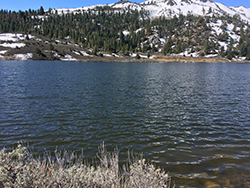
A long, wet winter has been good for Junction Reservoir and CDFW’s Kamloops rainbow trout that live there.
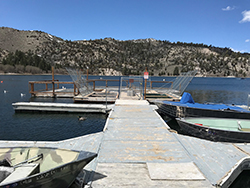
The June Lake Marina graciously offered up its net pens to CDFW’s Kamloops rainbow trout program when the drought forced CDFW to rescue its brood stock from a shrinking Junction Reservoir.
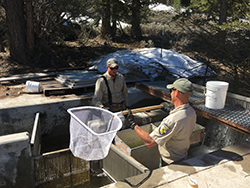
CDFW hatchery staffers Jimmy Sparks, left, and Drew Klingberg prepare to sex and sort Kamloops brood stock for later spawning, separating males from females as well as those females ready to spawn immediately versus those that need more time to ripen. The fish are returned to Junction Reservoir after spawning.
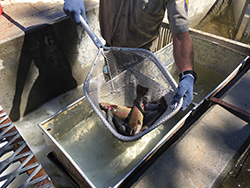
The offspring from these Kamloops will be raised at CDFW’s Fish Springs Trout Hatchery and stocked by airplane as fingerlings into backcountry waters across the state approved for trout stocking.
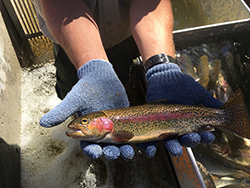
Resplendent in their spring spawning colors, Kamloops rainbow are raised and bred for their hard-fighting ability and wild nature that allows them to thrive in California’s remote backcountry waters and provide a thrill for anglers who catch them.
Junction Reservoir in Mono County is CDFW’s brood lake for the Kamloops rainbow trout, a hard-fighting strain originally from the Kamloops region of British Columbia.
The 20-acre lake sits on a private cattle ranch off-limits to fishing. It provides a secluded setting for the brood stock, whose progeny are used almost exclusively for the aerial stocking of backcountry waters throughout the state.
“We try to keep them raised in a more wild condition so they do better in the wild,” said Hot Creek Trout Hatchery Manager Mike Escallier. “They are a really fun fish to catch. They jump a lot. They will jump 3 feet out of the water when you hook one.”
And Junction Reservoir has never looked better. This spring, the lake was filled to the brim after a long, cold, wet winter. Near the mouth of the lake’s one small inlet, Kamloops were staging for a spawning run, their feisty nature on full display in the clear waters, breaking the surface occasionally and fighting each other over territory.
Kamloops further up the inlet were blocked from moving upstream by a concrete and metal trap. That’s where CDFW’s hatchery staff collect and sort the fish each spring, spawning them manually to produce the offspring that will be deposited as fingerlings this summer by airplane into backcountry waters approved for stocking.
The entire scene is a welcome sight after California’s drought nearly collapsed CDFW’s backcountry fish-stocking program. During the darkest days of the drought, the small inlet feeding into Junction Reservoir dried up. Combined with the years-long shortage of rain and snow, Junction Reservoir withered to about half its size. In 2013, CDFW conducted an emergency fish rescue to save about 2,000 of the brood fish and its backcountry trout stocking program altogether.
The rescued fish were relocated to CDFW trout hatcheries and other nearby waters for safe-keeping. The owners of the June Lake Marina provided a major assist, offering up some of their net pens on June Lake to CDFW and its Kamloops at no charge. The June Lake net pens continue to hold some Kamloops, which CDFW spawns each spring until the program transitions back fully to Junction Reservoir and CDFW’s Fish Springs Trout Hatchery south of Big Pine where the baby Kamloops are raised.
CDFW returned brood fish to Junction Reservoir in the spring of 2017 following a wet winter and heavy snowpack. CDFW is rebuilding production toward its annual goal of collecting and fertilizing 1.4 million eggs. Some of the offspring are put back into Junction Reservoir to add genetic diversity and different age classes to the rebuilding brood population as no natural spawning occurs in the lake.
One benchmark hatchery managers and biologists are striving toward is the return of Kamloops to Crowley Lake, where more anglers will have a chance to enjoy them.
Before the drought wreaked havoc on CDFW’s Kamloops program, a portion of the Kamloops produced each year were allocated to Crowley Lake. While the backcountry trout are sterile – or “triploid” – the fish stocked into Crowley are “diploids” capable of spawning naturally.
“They spawn at different times than other strains of rainbow trout,” explained Escallier. “They give anglers fishing the creeks opportunity. They tend to be running up the creeks from Crowley right around the trout opener.”
CDFW Photos. Top Photo: The inlet to Junction Reservoir is blocked by a fish trap where CDFW hatchery employees catch fish in the spring for spawning.
###
Media Contact:
Peter Tira, CDFW Communications, (916) 322-8908